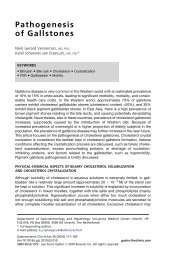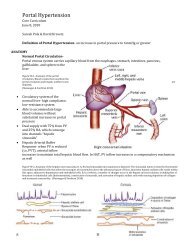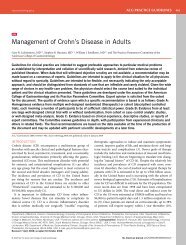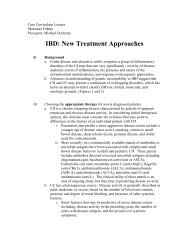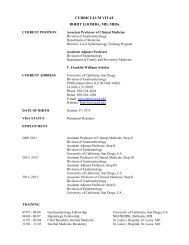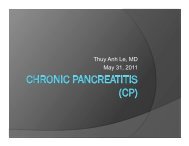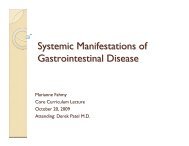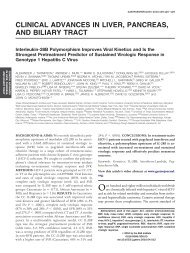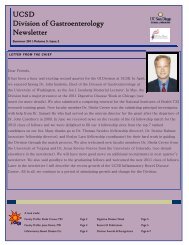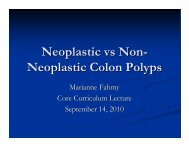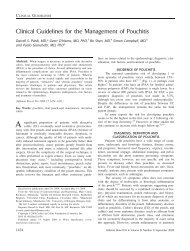<strong>Small</strong>-<strong>bowel</strong> <strong>imag<strong>in</strong>g</strong> <strong>in</strong> Crohn’s <strong>disease</strong>Solem et alprocedure and the will<strong>in</strong>gness to repeat the procedure <strong>in</strong>the future.Consensus reference standardAfter the results of the 4 studies (CTE, ileocolonoscopy,CE, and SBFT) were recorded for each patient, the f<strong>in</strong>d<strong>in</strong>gsof all of the studies were reviewed at the conclusionof the study period by a consensus panel of co-<strong>in</strong>vestigatorsrepresent<strong>in</strong>g each diagnostic modality and a referr<strong>in</strong>ggastroenterologist, to establish a consensus global assessmentof SB Crohn’s <strong>disease</strong>. If there were discordantresults among studies, this discussion necessitated achange of op<strong>in</strong>ion by one or more <strong>in</strong>vestigators about the<strong>in</strong>itial <strong>in</strong>terpretation of the f<strong>in</strong>d<strong>in</strong>gs of one or more studies.More specifically, the <strong>in</strong>vestigator represent<strong>in</strong>g one of thediagnostic modalities had to concede that a mistake hadbeen made <strong>in</strong> the <strong>in</strong>itial <strong>in</strong>terpretation of the SB f<strong>in</strong>d<strong>in</strong>gswith their modality. Thus, the reference standard for assessmentof Crohn’s <strong>disease</strong> activity was the f<strong>in</strong>al determ<strong>in</strong>ationof the consensus panel (ie, active, suspicious foractive, <strong>in</strong>active, or absent). The consensus criterion standardhas previously been used <strong>in</strong> a <strong>prospective</strong> trial oftests evaluat<strong>in</strong>g perianal Crohn’s <strong>disease</strong>. 42 After the modifiedread<strong>in</strong>gs were used to establish the consensus referencestandard for SB <strong>disease</strong>, the orig<strong>in</strong>al <strong>in</strong>terpretationof each study as recorded on the study forms, was usedto estimate the performance characteristics of the tests.In a prespecified primary analysis, the diagnoses of activeand suspicious SB Crohn’s <strong>disease</strong> were grouped together,and the diagnoses of <strong>in</strong>active or absent <strong>disease</strong>were grouped together, for all reported analyses to detectactive SB Crohn’s. A prespecified secondary analysis wasalso performed for detect<strong>in</strong>g the presence of SB Crohn’s<strong>disease</strong> by comb<strong>in</strong><strong>in</strong>g the categories of active, suspicious,and <strong>in</strong>active <strong>disease</strong>, and compar<strong>in</strong>g this group to the absentcategory. (However, the latter results were consistentwith those of active SB Crohn’s, and are therefore not reported<strong>in</strong> the Results.)Statistical analysisFor the primary analysis, the sensitivity of each test wascalculated by divid<strong>in</strong>g the number of patients with positivetest results by the number of patients with active or suspiciousSB Crohn’s <strong>disease</strong> based on the consensus criterionstandard. The specificity of each test was calculated by divid<strong>in</strong>gthe number of patients with negative tests resultsby the number of patients with <strong>in</strong>active or absent SBCrohn’s <strong>disease</strong> based on the consensus criterion standard.The diagnostic accuracy of each test was calculatedby the number of patients with test results <strong>in</strong> agreementwith the consensus criterion standard divided by the numberof tests performed. Exact b<strong>in</strong>omial 95% confidence <strong>in</strong>tervalswere also reported.The operat<strong>in</strong>g characteristics of each SB exam<strong>in</strong>ationwere compared to those of CE <strong>in</strong> the subset of patientshav<strong>in</strong>g both CE and another SB exam<strong>in</strong>ation. The sensitivity,specificity, and accuracy of CTE, ileocolonoscopy, andSBFT were compared to CE by us<strong>in</strong>g McNemar’s test ofpaired proportions. The comb<strong>in</strong>ed sensitivity, specificity,and accuracy of all pairs of tests that could be consideredwere also estimated aga<strong>in</strong>st the consensus criterion standard.McNemar’s test was used to compare the performancesof pairs of tests (CE plus CTE vs ileocolonoscopyplus SBFT, CE plus ileocolonoscopy vs CTE plus SBFT,and CTE plus ileocolonoscopy vs CE plus SBFT). Comparisonsof pairs conta<strong>in</strong><strong>in</strong>g a common diagnostic test were notperformed. The P values were not adjusted for multiplecomparisons.RESULTSForty-two patients enrolled <strong>in</strong> the study (Fig. 1). Onepatient withdrew for personal reasons before any diagnosticstudies were performed and was not <strong>in</strong>cluded <strong>in</strong> theanalysis. The median age of the 41 patients (81% female)participat<strong>in</strong>g <strong>in</strong> the study was 40.1 years (range 18.9-73.5years). Forty-one patients underwent CTE. One patientsubsequently withdrew for personal reasons and had nofurther studies. Ileoscopy was feasible <strong>in</strong> 36 of the 40 colonoscopies.Thirty-eight patients had SBFT exam<strong>in</strong>ationsafter 1 patient exited the study due to a stricture detectedon CTE, and 1 patient underwent surgery for a PSBO.Twenty-eight patients had CE studies after 10 patientswere excluded for PSBO or abscess, and 2 patients leftthe study for personal reasons. One capsule study was repeateddue to a technical malfunction with the <strong>in</strong>itialexam<strong>in</strong>ation (no images were obta<strong>in</strong>ed), and one capsulewas reta<strong>in</strong>ed <strong>in</strong> the stomach for the duration of batterylife, result<strong>in</strong>g <strong>in</strong> no SB images (but the capsule eventuallypassed spontaneously). Twenty-seven capsule studieswere then used for analysis. Table 1 details the comb<strong>in</strong>ationsof the 4 SB exam<strong>in</strong>ations patients received.The study co-<strong>in</strong>vestigators were able to reach a consensusop<strong>in</strong>ion regard<strong>in</strong>g the global assessment of SB Crohn’s<strong>disease</strong> after unbl<strong>in</strong>d<strong>in</strong>g at the conclusion of study <strong>in</strong> all 41patients who had one or more SB studies (Table 2). Thef<strong>in</strong>al cl<strong>in</strong>ical diagnoses for all patients, not limited to theSB, are reported <strong>in</strong> Table 3.Table 4 reports the sensitivity, specificity, and accuracyof the 4 SB tests <strong>in</strong>dividually, with the consensus criterionstandard used to classify patient status as either ‘‘active’’(active plus suspicious) or ‘‘<strong>in</strong>active’’ (<strong>in</strong>active plus absent).The sensitivity for the detection of active SB Crohn’s<strong>disease</strong> was 83% for CE, 82% for CTE, 74% for ileocolonoscopy,and 65% for SBFT. The specificity for SB Crohn’s<strong>disease</strong> was 100% for ileocolonoscopy, 94% for SBFT,89% for CTE, and 53% for CE. The overall accuracy forSB Crohn’s was 86% for ileocolonoscopy, 85% for CTE,79% for SBFT, and 67% for CE.The performance of CTE, ileocolonoscopy, and SBFTwere each compared with that of CE (Table 5). There258 GASTROINTESTINAL ENDOSCOPY Volume 68, No. 2 : 2008 www.giejournal.org
Solem et al<strong>Small</strong>-<strong>bowel</strong> <strong>imag<strong>in</strong>g</strong> <strong>in</strong> Crohn’s <strong>disease</strong>Figure 1. A graphic representation of patient movement throughout the course of the study.TABLE 1. Comb<strong>in</strong>ations of the 4 SB exam<strong>in</strong>ationsundergone by 42 participants <strong>in</strong>itially enrolled <strong>in</strong>the studyCE(n Z 27)Ileocolonoscopy(n Z 36)SBFT(n Z 38)CTE(n Z 41)No.patientsNo No No No 1No No No Yes 1No No Yes Yes 3No Yes No Yes 2No Yes Yes Yes 8Yes No Yes Yes 1Yes Yes Yes Yes 26CE, Capsule endoscopy; SBFT, small <strong>bowel</strong> follow-through; CTE,computed tomographic enterography.were 12 patients <strong>in</strong> each of 3 sensitivity comparisons, andfor specificity there were 15 patients, except to compareCE versus SBFT, where only 14 received both exam<strong>in</strong>ations.The sensitivity of CE (83%) was not significantly differentfrom that of CTE (67%, P Z .63), ileocolonoscopy(67%, P Z .69), or SBFT (50%, P Z .22). However, thespecificity of CE (53%) was significantly lower than thatfor either CTE (100%, P Z .02) or SBFT (100%, P Z.02). The specificity of CE (43%) was also significantlylower among the 14 patients hav<strong>in</strong>g ileocolonoscopy(100%, P Z .03). The lower specificity of CE was due toTABLE 2. F<strong>in</strong>al consensus diagnosis for small-<strong>bowel</strong>Crohn’s <strong>disease</strong> <strong>in</strong> 41 patients who underwent at least 1diagnostic test, and <strong>in</strong> 26 patients who underwent all 4tests<strong>Small</strong>-<strong>bowel</strong> Crohn’s<strong>disease</strong> diagnosisAll patients,n (%)*Patients withall 4 tests, n (%)yActive 21 (51) 11 (42)Absent 17 (42) 12 (46)Inactive 2 (5) 2 (8)Suspicious 1 (2) 1 (4)Total 41 (100) 26 (100)*Percentage of the group undergo<strong>in</strong>g at least 1 SB <strong>imag<strong>in</strong>g</strong> test.yPercentage of the group undergo<strong>in</strong>g all 4 tests.the fact that, <strong>in</strong> 7 patients, there were f<strong>in</strong>d<strong>in</strong>gs that ledthe CE reader to deem the exam<strong>in</strong>ation either suspicious(n Z 5) or ‘‘def<strong>in</strong>ite’’ (n Z 2) for active Crohn’s <strong>disease</strong>,but accord<strong>in</strong>g to the consensus criterion standard, thesepatients had either no evidence of Crohn’s <strong>disease</strong> (n Z5) or only <strong>in</strong>active <strong>disease</strong> (n Z 2).The performance characteristics of pairs of SB exam<strong>in</strong>ationsaga<strong>in</strong>st the consensus criterion standard were estimated(Table 4). A patient was classified positive foractive SB Crohn’s <strong>disease</strong> if either of the 2 exam<strong>in</strong>ations<strong>in</strong>dicated active <strong>disease</strong>. The sensitivity for comb<strong>in</strong>ationsof exam<strong>in</strong>ations ranged from a high of 100% for the CEand ileocolonoscopy comb<strong>in</strong>ation to a low of 78% forwww.giejournal.org Volume 68, No. 2 : 2008 GASTROINTESTINAL ENDOSCOPY 259



